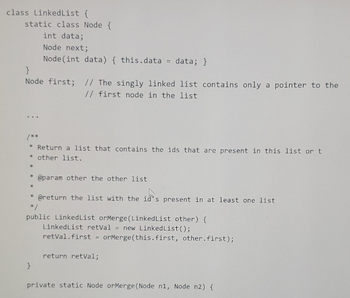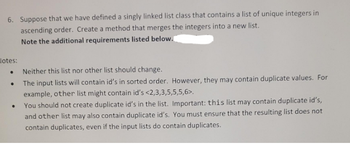
Database System Concepts
7th Edition
ISBN: 9780078022159
Author: Abraham Silberschatz Professor, Henry F. Korth, S. Sudarshan
Publisher: McGraw-Hill Education
expand_more
expand_more
format_list_bulleted
Concept explainers
Question

Transcribed Image Text:class Linked List {
static class Node {
}
Node first; // The singly linked list contains only a pointer to the
// first node in the list
*Return a list that contains the ids that are present in this list or t
* other list.
*
*
int data;
Node next;
Node (int data){ this.data= data; }
*
}
@param other the other list
@return the list with the id's present in at least one list
idrs
public Linked List orMerge(LinkedList other) {
Linked List retVal = new Linked List ();
retVal.first = orMerge(this.first, other.first);
return retVal;
private static Node orMerge (Node n1, Node n2) {

Transcribed Image Text:6. Suppose that we have defined a singly linked list class that contains a list of unique integers in
ascending order. Create a method that merges the integers into a new list.
Note the additional requirements listed below.
Notes:
Neither this list nor other list should change.
The input lists will contain id's in sorted order. However, they may contain duplicate values. For
example, other list might contain id's <2,3,3,5,5,5,6>.
You should not create duplicate id's in the list. Important: this list may contain duplicate id's,
and other list may also contain duplicate id's. You must ensure that the resulting list does not
contain duplicates, even if the input lists do contain duplicates.
Expert Solution
This question has been solved!
Explore an expertly crafted, step-by-step solution for a thorough understanding of key concepts.
Step by stepSolved in 4 steps with 3 images

Knowledge Booster
Learn more about
Need a deep-dive on the concept behind this application? Look no further. Learn more about this topic, computer-science and related others by exploring similar questions and additional content below.Similar questions
- member and non-member functions c++arrow_forwardWhat is the biggest advantage of linked list over array? Group of answer choices Unlike array, linked list can dynamically grow and shrink With linked list, it is faster to access a specific element than with array Linked list is easier to implement than array Unlike array, linked list can only hold a fixed number of elementsarrow_forwardfor c++ please thank you please type the code so i can copy and paste easily thanks. 4, List search Modify the linked listv class you created in the previous programming challange to include a member function named search that returns the position of a specific value, x, in the lined list. the first node in the list is at position 0, the second node is at position 1, and so on. if x is not found on the list, the search should return -1 test the new member function using an approprate driver program. here is my previous programming challange. #include <iostream> using namespace std; struct node { int data; node *next; }; class list { private: node *head,*tail; public: list() { head = NULL; tail = NULL; } ~list() { } void append() { int value; cout<<"Enter the value to append: "; cin>>value; node *temp=new node; node *s; temp->data = value; temp->next = NULL; s = head; if(head==NULL) head=temp; else { while (s->next != NULL) s = s->next; s->next =…arrow_forward
- C++ Program #include <iostream>#include <cstdlib>#include <ctime>using namespace std; int getData() { return (rand() % 100);} class Node {public: int data; Node* next;}; class LinkedList{public: LinkedList() { // constructor head = NULL; } ~LinkedList() {}; // destructor void addNode(int val); void addNodeSorted(int val); void displayWithCount(); int size(); void deleteAllNodes(); bool exists(int val);private: Node* head;}; // function to check data exist in a listbool LinkedList::exists(int val){ if (head == NULL) { return false; } else { Node* temp = head; while (temp != NULL) { if(temp->data == val){ return true; } temp = temp->next; } } return false;} // function to delete all data in a listvoid LinkedList::deleteAllNodes(){ if (head == NULL) { cout << "List is empty, No need to delete…arrow_forwardC++The List class represents a linked list of dynamically allocated elements. The list has only one member variable head which is a pointer that leads to the first element. See the following code for the copy constructor to List. List (const List & list) { for (int i = 0; i <list.size (); i ++) { push_back (list [i]); } } What problems does the copy constructor have? Select one or more options: 1. List (const List & list) {} does not define a copy constructor. 2. The list parameter should not be constant. 3. The new elements will be added to the wrong list. 4. Copy becomes shallow rather than deep. 5. The copy will create dangling pointers. 6. Copying will create memory leaks. 7. The condition must be: i <size () 8. head is never initialized.arrow_forwardstruct insert_at_back_of_sll { // Function takes a constant Book as a parameter, inserts that book at the // back of a singly linked list, and returns nothing. void operator()(const Book& book) { /// TO-DO (3) /// // Write the lines of code to insert "book" at the back of "my_sll". Since // the SLL has no size() function and no tail pointer, you must walk the // list looking for the last node. // // HINT: Do not attempt to insert after "my_sll.end()". // ///// END-T0-DO (3) ||||// } std::forward_list& my_sll; };arrow_forward
- C++ Data Structure:Create an AVL Tree C++ class that works similarly to std::map, but does NOT use std::map. In the PRIVATE section, any members or methods may be modified in any way. Standard pointers or unique pointers may be used.** MUST use given Template below: #ifndef avltree_h#define avltree_h #include <memory> template <typename Key, typename Value=Key> class AVL_Tree { public: classNode { private: Key k; Value v; int bf; //balace factor std::unique_ptr<Node> left_, right_; Node(const Key& key) : k(key), bf(0) {} Node(const Key& key, const Value& value) : k(key), v(value), bf(0) {} public: Node *left() { return left_.get(); } Node *right() { return right_.get(); } const Key& key() const { return k; } const Value& value() const { return v; } const int balance_factor() const {…arrow_forwardCourse: Data Structure and Algorithims Language: Java Kindly make the program in 2 hours. Task is well explained. You have to make the proogram properly in Java: Restriction: Prototype cannot be change you have to make program by using given prototype. TAsk: Create a class Node having two data members int data; Node next; Write the parametrized constructor of the class Node which contain one parameter int value assign this value to data and assign next to null Create class LinkList having one data members of type Node. Node head Write the following function in the LinkList class publicvoidinsertAtLast(int data);//this function add node at the end of the list publicvoid insertAthead(int data);//this function add node at the head of the list publicvoid deleteNode(int key);//this function find a node containing "key" and delete it publicvoid printLinkList();//this function print all the values in the Linklist public LinkListmergeList(LinkList l1,LinkList l2);// this function…arrow_forwardC++ The List class represents a linked list of dynamically allocated elements. The list has only one member variable head which is a pointer that leads to the first element. See the following code for the destructor to List. ~ List () { for (int i = 0; i <size (); i ++) { pop_back (); } } What problems does the destructor have? Select one or more options: 1. There are no parameters for the destructor. 2. The return value from pop_back (if any) is nerver handled. 3. The destructor will create a stack overflow. 4. The destructor will create dangling pointers. 5.The destructor will create memory leaks. 6.The destructor will create undefined behavior (equivalent to zero pointer exception). 7.The condition must be: i <size () - 1 8. There is at least one problem with the destructor, but none of the above.arrow_forward
arrow_back_ios
arrow_forward_ios
Recommended textbooks for you
 Database System ConceptsComputer ScienceISBN:9780078022159Author:Abraham Silberschatz Professor, Henry F. Korth, S. SudarshanPublisher:McGraw-Hill Education
Database System ConceptsComputer ScienceISBN:9780078022159Author:Abraham Silberschatz Professor, Henry F. Korth, S. SudarshanPublisher:McGraw-Hill Education Starting Out with Python (4th Edition)Computer ScienceISBN:9780134444321Author:Tony GaddisPublisher:PEARSON
Starting Out with Python (4th Edition)Computer ScienceISBN:9780134444321Author:Tony GaddisPublisher:PEARSON Digital Fundamentals (11th Edition)Computer ScienceISBN:9780132737968Author:Thomas L. FloydPublisher:PEARSON
Digital Fundamentals (11th Edition)Computer ScienceISBN:9780132737968Author:Thomas L. FloydPublisher:PEARSON C How to Program (8th Edition)Computer ScienceISBN:9780133976892Author:Paul J. Deitel, Harvey DeitelPublisher:PEARSON
C How to Program (8th Edition)Computer ScienceISBN:9780133976892Author:Paul J. Deitel, Harvey DeitelPublisher:PEARSON Database Systems: Design, Implementation, & Manag...Computer ScienceISBN:9781337627900Author:Carlos Coronel, Steven MorrisPublisher:Cengage Learning
Database Systems: Design, Implementation, & Manag...Computer ScienceISBN:9781337627900Author:Carlos Coronel, Steven MorrisPublisher:Cengage Learning Programmable Logic ControllersComputer ScienceISBN:9780073373843Author:Frank D. PetruzellaPublisher:McGraw-Hill Education
Programmable Logic ControllersComputer ScienceISBN:9780073373843Author:Frank D. PetruzellaPublisher:McGraw-Hill Education

Database System Concepts
Computer Science
ISBN:9780078022159
Author:Abraham Silberschatz Professor, Henry F. Korth, S. Sudarshan
Publisher:McGraw-Hill Education

Starting Out with Python (4th Edition)
Computer Science
ISBN:9780134444321
Author:Tony Gaddis
Publisher:PEARSON

Digital Fundamentals (11th Edition)
Computer Science
ISBN:9780132737968
Author:Thomas L. Floyd
Publisher:PEARSON

C How to Program (8th Edition)
Computer Science
ISBN:9780133976892
Author:Paul J. Deitel, Harvey Deitel
Publisher:PEARSON

Database Systems: Design, Implementation, & Manag...
Computer Science
ISBN:9781337627900
Author:Carlos Coronel, Steven Morris
Publisher:Cengage Learning

Programmable Logic Controllers
Computer Science
ISBN:9780073373843
Author:Frank D. Petruzella
Publisher:McGraw-Hill Education